Early years
Mary Hockerday was born on 13 May 1842 at Pollard Street in Bethnal Green, the daughter
of Thomas Hockerday and Ann Maria Sutton. By 1848, she had three sisters and a brother,
another brother, Thomas Henry, having died in infancy. Hers was not an easy start
in life, although if one had asked her, she would probably have said that it was
no different to that of her friends and neighbours. Her mother died in 1848 when
she was only six years old, and was followed by a succession of step-mothers, the
first of which was Elizabeth Durham, a 38-year old widow who, by 1850 had already
buried three of her five children. Elizabeth herself did not survived much longer,
dying in January 1854 of consumption.
After Elizabeth’s death, Mary Ann found herself with a second step-mother, Elizabeth
Pratt (née Reader) whom her father married in May 1854. This arrangement did not
last long and by 1857, Mary Ann’s father had separated from Elizabeth to live with
Esther Bostock (née Steward). Esther was a widowed silk weaver from Spitalfields
who had five children from her marriage to George Bostock, ranging from six to 18
years of age. This meant that Thomas and Esther’s combined family numbered around
eleven children.
By the time of her father’s ‘marriage’, Mary Ann was working as a silk weaver. The
silk weaving industry had once flourished in Spitalfields and Bethnal Green, but
had been in terminal decline for some years and the silk weavers of Bethnal Green
were, for the most part, out of work. Those that did have employment, worked long
hours for low wages.
The Old Nichol
By August 1866, Mary Ann had left home and was living at 1 Nichols Row. It was one
of the streets that comprised the notorious area known as the Old Nichol. The area
was a dense network of about thirty streets, courts and alleys spread over fifteen
acres 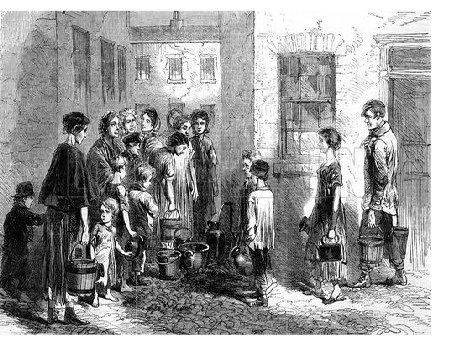 filled with tenement buildings, some so close together that a man had to turn
sideways to pass between them. The photograph on the left shows Little Collingwood
Street in about 1900. The buildings were badly built, and lack of proper foundations
and cheap building material meant that the damp soaked down from the rafters and
up from the ground to meet in the middle, causing the walls to bow and shed their
plaster. By the 1880s it was known as the worst slum in London. Over half the houses
in the Nichol consisted of one-room dwellings and a reporter for The Builder found
48 people in a six-roomed house. “To supply these with water, a stream runs for ten
or twelve minutes each day, except Sunday, from a small tap at the back of one of
the houses...”. This rabbit warren, barely fit for human habitation, was home to
over 5,700 people.
filled with tenement buildings, some so close together that a man had to turn
sideways to pass between them. The photograph on the left shows Little Collingwood
Street in about 1900. The buildings were badly built, and lack of proper foundations
and cheap building material meant that the damp soaked down from the rafters and
up from the ground to meet in the middle, causing the walls to bow and shed their
plaster. By the 1880s it was known as the worst slum in London. Over half the houses
in the Nichol consisted of one-room dwellings and a reporter for The Builder found
48 people in a six-roomed house. “To supply these with water, a stream runs for ten
or twelve minutes each day, except Sunday, from a small tap at the back of one of
the houses...”. This rabbit warren, barely fit for human habitation, was home to
over 5,700 people.
The conditions meant that inhabitants of the Nichol were almost twice as likely to
die than those in other areas of Bethnal Green; a shocking statistic given that mortality
rates in Bethnal Green were some of the highest in the capital. In an article of
1863, T he Illustrated London News summed up life there as "one painful and monotonous
round of vice, filth, and poverty, huddled in dark cellars, ruined garrets, bare
and blackened rooms, teeming with disease and death, and without the means, even
if there were the inclination, for the most ordinary observations of decency or cleanliness”.
It was into this world that Mary Ann’s son was born on 18 August 1866. She named
him James, although whose child he was in unknown;
he Illustrated London News summed up life there as "one painful and monotonous
round of vice, filth, and poverty, huddled in dark cellars, ruined garrets, bare
and blackened rooms, teeming with disease and death, and without the means, even
if there were the inclination, for the most ordinary observations of decency or cleanliness”.
It was into this world that Mary Ann’s son was born on 18 August 1866. She named
him James, although whose child he was in unknown; 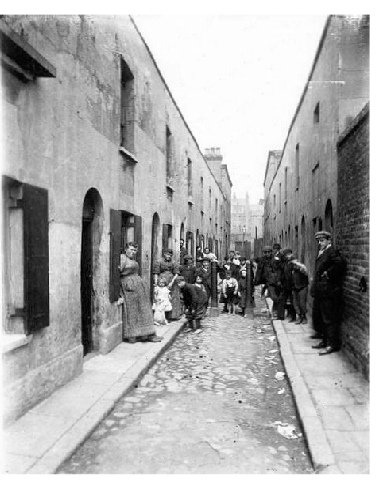 when he was baptised on 9 September
1866 at the Church of St Matthias, Bethnal Green, no father’s name was entered into
the baptism register (shown below). Living in the Old Nichol, young James had a three
in four chance of surviving infancy. As for Mary Ann, her best chance was to find
a husband, which she did. Henry Pegley (who may have been young James’ father) was
a toy maker from St Luke’s living in Bethnal Green. Mary Ann married him on 22 April
1867 at the Church of St James the Great, Bethnal Green. Like all couples who married
at the Church, the vicar did not charge for the service and, at the end of it, presented
them with a sixpence and a loaf of bread to help them start their married life. These
measures had been introduced in 1852 in an attempt to help couples who could not
otherwise afford to marry to keep faith with Christian teachings and, one assumes,
to prevent couples from ‘living in sin’. In many cases, including that of Mary Ann,
it failed to have the desired effect. Three years after Mary Ann’s wedding to Henry
Pegley, on 25 October 1870, Mary Ann gave birth to a son; the father was not Henry,
but James George Bostock.
when he was baptised on 9 September
1866 at the Church of St Matthias, Bethnal Green, no father’s name was entered into
the baptism register (shown below). Living in the Old Nichol, young James had a three
in four chance of surviving infancy. As for Mary Ann, her best chance was to find
a husband, which she did. Henry Pegley (who may have been young James’ father) was
a toy maker from St Luke’s living in Bethnal Green. Mary Ann married him on 22 April
1867 at the Church of St James the Great, Bethnal Green. Like all couples who married
at the Church, the vicar did not charge for the service and, at the end of it, presented
them with a sixpence and a loaf of bread to help them start their married life. These
measures had been introduced in 1852 in an attempt to help couples who could not
otherwise afford to marry to keep faith with Christian teachings and, one assumes,
to prevent couples from ‘living in sin’. In many cases, including that of Mary Ann,
it failed to have the desired effect. Three years after Mary Ann’s wedding to Henry
Pegley, on 25 October 1870, Mary Ann gave birth to a son; the father was not Henry,
but James George Bostock.

Family life
Mary Ann probably first met J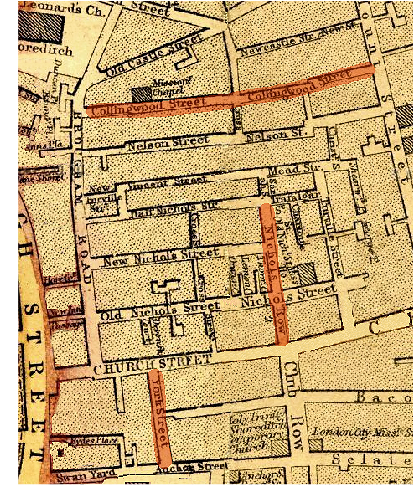 ames George in the 1850s when she was about 15 years
old. He was two years younger than her and the son of Esther and George Bostock.
When the widowed Esther started living with Thomas Hockerday in about 1857, Mary
Ann and James George became, in practice if not law, step-brother and -sister, although
James George continued to live with his grandmother. Taking this into account, it
is difficult to understand why, if Mary Ann and James George had known one another
since their teens, Mary Ann had married Henry Pegley; one explanation is that Henry
was the father of Mary Ann’s child, James. It is also possible that Mary Ann was
pregnant with James George Bostock’s child when she left her husband, Henry, only
a few years after their marriage. It was a tangled web.
ames George in the 1850s when she was about 15 years
old. He was two years younger than her and the son of Esther and George Bostock.
When the widowed Esther started living with Thomas Hockerday in about 1857, Mary
Ann and James George became, in practice if not law, step-brother and -sister, although
James George continued to live with his grandmother. Taking this into account, it
is difficult to understand why, if Mary Ann and James George had known one another
since their teens, Mary Ann had married Henry Pegley; one explanation is that Henry
was the father of Mary Ann’s child, James. It is also possible that Mary Ann was
pregnant with James George Bostock’s child when she left her husband, Henry, only
a few years after their marriage. It was a tangled web.
In these early years of her relationship with James George Bostock, Mary Ann supplemented
the family’s income by silk weaving, although by this time, the industry was a shadow
of its former self and the majority of East End silk weavers were out of work or
had taken other employment. The centre of the silk weaving industry had been Spitalfields
and Bethnal Green and it was here that Mary Ann and her family lived until the early
1880s. During this period, Mary Ann gave birth to four more children: Albert (1872),
Esther Harriet (1877), Edwin Francis (1879) and Rosina (1880). In 1881 there was
a brief move to Cullum Street in West Ham. It was after returning from West Ham that
Mary Ann and James George finally married on 21 May 1883 at the Church of St Thomas.
The marriage was witnessed by James George’s sister, Ann Martha Hart (née Bostock).
No evidence has been discovered yet about this date. A logical conclusion would be
that Henry Pegley had died, leaving Mary Ann a widow and free to marry James George.
However, the only death certificates that have been found date from 1890 and 1892.
Interesting, there is a marriage entry for Henry Pegley (a toy maker and the son
of William Pegley, a toy maker) to a Caroline Diss in November 1870. On paper, the
evidence suggests that the two Henry Pegleys were one and the same; in the nineteenth
century, divorce was expensive and difficult and bigamy was not uncommon, but if
Henry (and later Mary Ann) were guilty, it was a brazen act, although perhaps if
both parties were in agreement, the chances of being caught and punished were slight.
Details about the twenty-five years from 1883 to 1908 are scant. In 1891, Mary Ann
and her family were living in Bethnal Green; unlike many families, they were renting
the whole house. Mary Ann was no longer working, her day filled with taking care
of the house and her family. On the night of the 1901 census, James George was in
hospital suffering with gout; Mary Ann’s whereabouts have not been traced but she
was not staying with any of her children.
A turn for the worse
By the 1900s, James George was sixty years old and suffering with gout. He may have
found it difficult to work and finances were difficult. Mary Ann may have worked
in a tobacconist newsagents to help supplement the family income. In 1909, an event
occurred that was to have a profound effect on both Mary Ann and James George. On
6 August 1909, Mary Ann’s daughter, Esther, took her to Shoreditch Infirmary and
Workhouse where she was admitted as a ‘pauper lunatic’ and ‘a person requiring to
be dealt with in accordance with the provisions of the Lunacy Act’. A medical report
attests that she was ‘clean’ and her bodily condition ‘fair’, but she had ‘scars
on left breast and back and left thigh and right wrist’ (the image on the left shows
part of the report). James George was in Shoreditch Infirmary.
The events leading up to this incident are unclear. According to Mary Ann’s g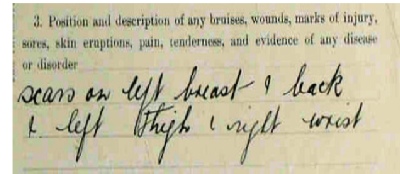 randdaughter,
Irene, Mary Ann was twice robbed and badly beaten whilst working in the tobacconist
newsagents. The second time, in early July 1909, the family returned home to find
her weeping, with blood pouring from her head and tearing up papers and documents,
saying that if she burnt them “they can’t hurt me any more”. The 1871 census records
that a ‘Mary Ann Bostock’ ran a tobacconist at 2 Pritchard’s Place, an address associated
with the Bostock family since the 1860s; this was most probably James George’s aunt,
Mary Ann Bostock (née Welsford), but is is possible that by the 1900s, Mary Ann
(née Hockerday) was running the shop.
randdaughter,
Irene, Mary Ann was twice robbed and badly beaten whilst working in the tobacconist
newsagents. The second time, in early July 1909, the family returned home to find
her weeping, with blood pouring from her head and tearing up papers and documents,
saying that if she burnt them “they can’t hurt me any more”. The 1871 census records
that a ‘Mary Ann Bostock’ ran a tobacconist at 2 Pritchard’s Place, an address associated
with the Bostock family since the 1860s; this was most probably James George’s aunt,
Mary Ann Bostock (née Welsford), but is is possible that by the 1900s, Mary Ann
(née Hockerday) was running the shop.
During the time that Mary Ann was in Shoreditch Workhouse, she was examined and declared
to be a person of ‘unsound mind’. The doctor commented that ‘she is restless, her
memory is defective, she wanders about the ward, c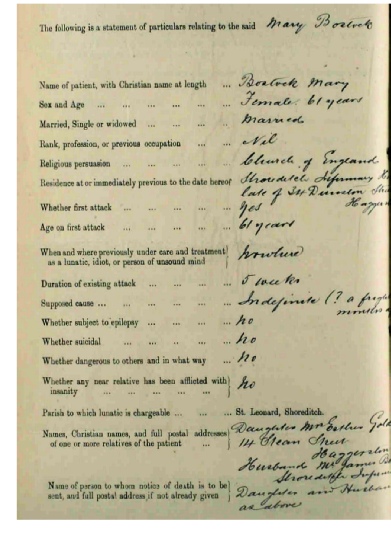 annot give a relevant account of
her recent doings’, and again ‘she is quite lost, fancies she has been out this morning;
she cannot give a relevant account of her recent doings, her memory is very defective’.
On 4 September the doctor committed her to the care of Long Grove Asylum in Epsom,
Surrey as someone of ‘unsound mind’, although neither suicidal nor a danger to others.
The medical records give little clue as to the cause of her mental state: in the
medical report for Long Grove under supposed cause, the word ‘indefinite’ has been
written, although to one side and in brackets is written (? a fright... and then
a word which is indecipherable). If the story recounted to Irene is true, then it
would indicate that Mary Ann was suffering from post-traumatic stress.
annot give a relevant account of
her recent doings’, and again ‘she is quite lost, fancies she has been out this morning;
she cannot give a relevant account of her recent doings, her memory is very defective’.
On 4 September the doctor committed her to the care of Long Grove Asylum in Epsom,
Surrey as someone of ‘unsound mind’, although neither suicidal nor a danger to others.
The medical records give little clue as to the cause of her mental state: in the
medical report for Long Grove under supposed cause, the word ‘indefinite’ has been
written, although to one side and in brackets is written (? a fright... and then
a word which is indecipherable). If the story recounted to Irene is true, then it
would indicate that Mary Ann was suffering from post-traumatic stress.
Long Grove
Long Grove in Surrey was the third asylum constructed on the Horton Estate, and one
of a cluster of hospitals built to house the mentally ill. It opened in June 1907
and was designed to house 2,000 patients. As well as eight male and eight female
blocks, there was an administration block, recreation hall, male and female staff
blocks, kitchens, and main store. Gender specific workplaces such as laundry, workshops
and boiler house were also built on the side relating to their respective workforces.
There was a large semi-circular corridor with spur corridors making the entire main
complex easily accessible. The photograph on the left shows the main block in the
early twentieth century.
In the grounds were a water tower, parole and infirmary blocks, a chapel, senior
staff and official's housing and an isolation hospital. The hospital was regarded
as a showpiece and a report by the 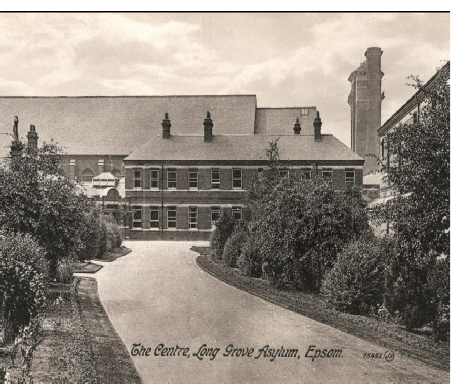 Commissioners from March 1911 records that: ‘The
wards, dormitories and all parts of the building were in excellent order, and there
is a good supply of books, and of flowers, birds and objects of various kinds to
brighten the rooms and interest their inmates’. In addition, the grounds were exceptionally
well maintained and included a collection of rare trees, and the medical staff were
excellent.
Commissioners from March 1911 records that: ‘The
wards, dormitories and all parts of the building were in excellent order, and there
is a good supply of books, and of flowers, birds and objects of various kinds to
brighten the rooms and interest their inmates’. In addition, the grounds were exceptionally
well maintained and included a collection of rare trees, and the medical staff were
excellent.
Based on this report, life was probably quite pleasant for Mary Ann, but a far cry
from the hustle and bustle of her life in the east end of London. It is difficult
to know how much she was aware of her surroundings, or whether her condition worsened.
Whatever the case, Mary Ann was not at Long Grove for long. She died two years after
being admitted on 5 November 1911. The cause of death was given as a ‘fatty degeneration
of the heart’ and ‘arteriosclerosis (which is a hardening of the arteries); as the
main causes are smoking, obesity, diet and high blood pressure, no doubt most of
the damage had been done well before she entered Long Grove.


 filled with tenement buildings, some so close together that a man had to turn
sideways to pass between them. The photograph on the left shows Little Collingwood
Street in about 1900. The buildings were badly built, and lack of proper foundations
and cheap building material meant that the damp soaked down from the rafters and
up from the ground to meet in the middle, causing the walls to bow and shed their
plaster. By the 1880s it was known as the worst slum in London. Over half the houses
in the Nichol consisted of one-
filled with tenement buildings, some so close together that a man had to turn
sideways to pass between them. The photograph on the left shows Little Collingwood
Street in about 1900. The buildings were badly built, and lack of proper foundations
and cheap building material meant that the damp soaked down from the rafters and
up from the ground to meet in the middle, causing the walls to bow and shed their
plaster. By the 1880s it was known as the worst slum in London. Over half the houses
in the Nichol consisted of one- he Illustrated London News summed up life there as "one painful and monotonous
round of vice, filth, and poverty, huddled in dark cellars, ruined garrets, bare
and blackened rooms, teeming with disease and death, and without the means, even
if there were the inclination, for the most ordinary observations of decency or cleanliness”.
It was into this world that Mary Ann’s son was born on 18 August 1866. She named
him James, although whose child he was in unknown;
he Illustrated London News summed up life there as "one painful and monotonous
round of vice, filth, and poverty, huddled in dark cellars, ruined garrets, bare
and blackened rooms, teeming with disease and death, and without the means, even
if there were the inclination, for the most ordinary observations of decency or cleanliness”.
It was into this world that Mary Ann’s son was born on 18 August 1866. She named
him James, although whose child he was in unknown;  when he was baptised on 9 September
1866 at the Church of St Matthias, Bethnal Green, no father’s name was entered into
the baptism register (shown below). Living in the Old Nichol, young James had a three
in four chance of surviving infancy. As for Mary Ann, her best chance was to find
a husband, which she did. Henry Pegley (who may have been young James’ father) was
a toy maker from St Luke’s living in Bethnal Green. Mary Ann married him on 22 April
1867 at the Church of St James the Great, Bethnal Green. Like all couples who married
at the Church, the vicar did not charge for the service and, at the end of it, presented
them with a sixpence and a loaf of bread to help them start their married life. These
measures had been introduced in 1852 in an attempt to help couples who could not
otherwise afford to marry to keep faith with Christian teachings and, one assumes,
to prevent couples from ‘living in sin’. In many cases, including that of Mary Ann,
it failed to have the desired effect. Three years after Mary Ann’s wedding to Henry
Pegley, on 25 October 1870, Mary Ann gave birth to a son; the father was not Henry,
but James George Bostock.
when he was baptised on 9 September
1866 at the Church of St Matthias, Bethnal Green, no father’s name was entered into
the baptism register (shown below). Living in the Old Nichol, young James had a three
in four chance of surviving infancy. As for Mary Ann, her best chance was to find
a husband, which she did. Henry Pegley (who may have been young James’ father) was
a toy maker from St Luke’s living in Bethnal Green. Mary Ann married him on 22 April
1867 at the Church of St James the Great, Bethnal Green. Like all couples who married
at the Church, the vicar did not charge for the service and, at the end of it, presented
them with a sixpence and a loaf of bread to help them start their married life. These
measures had been introduced in 1852 in an attempt to help couples who could not
otherwise afford to marry to keep faith with Christian teachings and, one assumes,
to prevent couples from ‘living in sin’. In many cases, including that of Mary Ann,
it failed to have the desired effect. Three years after Mary Ann’s wedding to Henry
Pegley, on 25 October 1870, Mary Ann gave birth to a son; the father was not Henry,
but James George Bostock.
 ames George in the 1850s when she was about 15 years
old. He was two years younger than her and the son of Esther and George Bostock.
When the widowed Esther started living with Thomas Hockerday in about 1857, Mary
Ann and James George became, in practice if not law, step-
ames George in the 1850s when she was about 15 years
old. He was two years younger than her and the son of Esther and George Bostock.
When the widowed Esther started living with Thomas Hockerday in about 1857, Mary
Ann and James George became, in practice if not law, step- randdaughter,
Irene, Mary Ann was twice robbed and badly beaten whilst working in the tobacconist
newsagents. The second time, in early July 1909, the family returned home to find
her weeping, with blood pouring from her head and tearing up papers and documents,
saying that if she burnt them “they can’t hurt me any more”. The 1871 census records
that a ‘Mary Ann Bostock’ ran a tobacconist at 2 Pritchard’s Place, an address associated
with the Bostock family since the 1860s; this was most probably James George’s aunt,
Mary Ann Bostock (née Welsford), but is is possible that by the 1900s, Mary Ann
(née Hockerday) was running the shop.
randdaughter,
Irene, Mary Ann was twice robbed and badly beaten whilst working in the tobacconist
newsagents. The second time, in early July 1909, the family returned home to find
her weeping, with blood pouring from her head and tearing up papers and documents,
saying that if she burnt them “they can’t hurt me any more”. The 1871 census records
that a ‘Mary Ann Bostock’ ran a tobacconist at 2 Pritchard’s Place, an address associated
with the Bostock family since the 1860s; this was most probably James George’s aunt,
Mary Ann Bostock (née Welsford), but is is possible that by the 1900s, Mary Ann
(née Hockerday) was running the shop.  annot give a relevant account of
her recent doings’, and again ‘she is quite lost, fancies she has been out this morning;
she cannot give a relevant account of her recent doings, her memory is very defective’.
On 4 September the doctor committed her to the care of Long Grove Asylum in Epsom,
Surrey as someone of ‘unsound mind’, although neither suicidal nor a danger to others.
The medical records give little clue as to the cause of her mental state: in the
medical report for Long Grove under supposed cause, the word ‘indefinite’ has been
written, although to one side and in brackets is written (? a fright... and then
a word which is indecipherable). If the story recounted to Irene is true, then it
would indicate that Mary Ann was suffering from post-
annot give a relevant account of
her recent doings’, and again ‘she is quite lost, fancies she has been out this morning;
she cannot give a relevant account of her recent doings, her memory is very defective’.
On 4 September the doctor committed her to the care of Long Grove Asylum in Epsom,
Surrey as someone of ‘unsound mind’, although neither suicidal nor a danger to others.
The medical records give little clue as to the cause of her mental state: in the
medical report for Long Grove under supposed cause, the word ‘indefinite’ has been
written, although to one side and in brackets is written (? a fright... and then
a word which is indecipherable). If the story recounted to Irene is true, then it
would indicate that Mary Ann was suffering from post- Commissioners from March 1911 records that: ‘The
wards, dormitories and all parts of the building were in excellent order, and there
is a good supply of books, and of flowers, birds and objects of various kinds to
brighten the rooms and interest their inmates’. In addition, the grounds were exceptionally
well maintained and included a collection of rare trees, and the medical staff were
excellent.
Commissioners from March 1911 records that: ‘The
wards, dormitories and all parts of the building were in excellent order, and there
is a good supply of books, and of flowers, birds and objects of various kinds to
brighten the rooms and interest their inmates’. In addition, the grounds were exceptionally
well maintained and included a collection of rare trees, and the medical staff were
excellent.